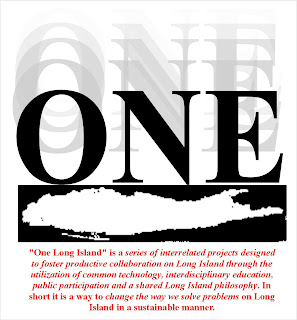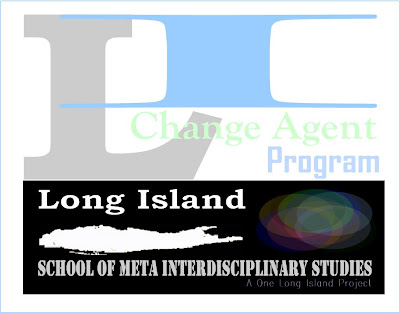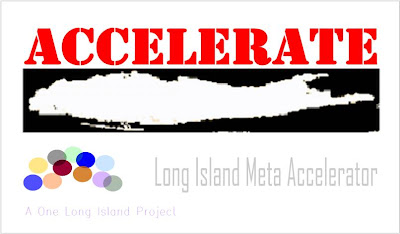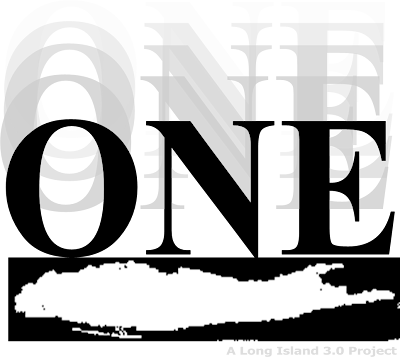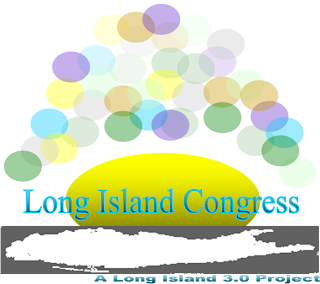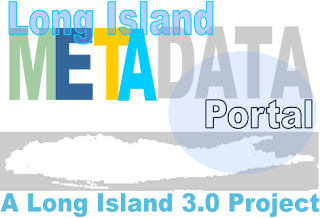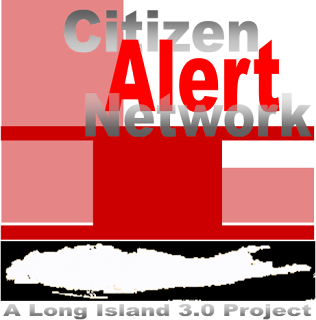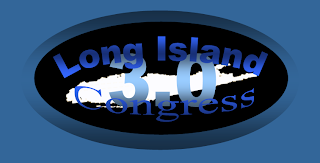Good article by Jerry Kremer in the Long Island Buiness News where he kindly references my Oyster Bay 2000 plan. Just one thing he got wrong. I won my race for Town Board in 1993.
Maybe Oyster Bay 2000 was the reason .... maybe just dumb luck. Who knows?
Full text of Jerry's article:
Yes, Virginia, there’s too much government
By Jerry Kremer
Friday, March 30, 2007
One-day business trips to some far-off city usually end with a lot of fatigue and not much to show for it.
My recent trip to Virginia confirms what a group called the Rauch Foundation announced in a newly released study, which complains that Long Island has too much government.
From the minute the cab driver drops you off in Northern Virginia, there is a marked difference in the look and feel of the residential and business community. Things are happening in suburban Fairfax and Loudon counties, which are not far from downtown Washington; the Rauch study compared those two Virginia counties with how things function on Long Island.
Long Islanders pay 50 percent more in property taxes and are not particularly satisfied with their local elected officials. But the most glaring finding of the study is not exactly a big secret: Long Island has 127 school districts for a population of 2.8 million people, while the two Virginia counties – with 1.3 million people – have three school districts.
Long Island school districts spend more per student on construction costs, even though the Virginia counties are building as many as six new schools in a year. The Virginia counties have 58 fire stations, compared with 381 on Long Island. One could go on and on contrasting the regions, but all the statistics all end with the same results: Long Island is overtaxed and overburdened.
County Executives Levy and Suozzi both agree that we have too much government and have pledged to do something about it, but their powers are limited. Many of the Island’s 400 government taxing districts have been created by the state Legislature, and you can’t abolish them without Albany’s approval.
It’s hard to pinpoint why the Island has so much government, but it isn’t a recent happening. Many of our towns and villages were created in the 1700s and most communities cherish their status. Everyone likes having their own school district, so their children can wear a sweatshirt with a community logo.
The effort to consolidate school districts in Suffolk County is not new. Many years ago, then-County Executive Patrick Halpin formed a commission to investigate school mergers. I chaired that group. We devoted countless hours to an in-depth report that pinpointed which school districts should be consolidated and why.
The study showed there were districts still in existence that transported all their children to other districts. There were districts with only one school building. At least 15 districts wanted to be merged with their next-door neighbors, but their neighbors didn’t want them – even though state law gives financial incentives to any district that welcome a merger with a neighbor.
Suffolk’s Levy has urged villages, towns and school districts to combine such services as security, borrowing, health insurance and transportation. The last known candidate for office who advocated consolidating specific departments was Oyster Bay’s Louis Savinetti. He had a program, flow charts and specifics. He lost.Nassau’s Suozzi is pushing for a $750,000 study on reducing layers of government, and has gotten the Hagendorn Foundation to contribute $250,000 to that effort. That sounds encouraging, but in the end, the leaders of the Island’s many fiefdoms will have to decide their own future – and to date, there is no record of any elected official, anywhere in this state, voting him- or herself out of office
Friday, March 30, 2007
Thursday, March 29, 2007
Long Island Metadata Project: Part One

Another useful tool in helping Long Island to "get organized" would be for some of our great colleges and universities in cooperation with state and local government and community organizations, to implement a Long Island Metadata Project (LIMDP). My apologies if someone is already doing this. I haven't come across it yet apart from some science related information. (Refer to Oyster Bay 2000 chart "Central Data Access/ Multi Platform" )
The LIMDP could established in conjunction with the SUNY Portal project (presuming it will be constructed to an "open architecture" platform) or as a different project based exclusively on Long Island with links to other projects. Perhaps the new LIFT Innovation Centers Project and other New York State NextGen Projects (both good variants of the Business Accelerator Model in The Port of Technology) could work cooperatively to create the correct environment of better communication. It seems Long Island and New York State have a lot of the correct elements in place and many very intelligent people from all walks of life ready to help our economy and our standard of living. We just need a little help organizing and working cooperatively to a achieve our goals (reference Oyster Bay 2000 "Community Congress" ).
Again the key is establishing a set of "open" standards and API that all such projects will adhere to. This still allow for creativity, competition and innovation while setting the framework for cooperation and information sharing and reasoned analysis. We still may not all agree on the results or how to proceed (human nature) but we are closer to having a unified approach to problem solving. When standards change in the future as inevitably they must, we then have a way to move together in unison rather than having to start from scratch.
Combined with XML, data mining and other relevant technologies, the LIDMP could be a simple and productive first step to having Long Islanders speak a common language and begin to chart a more productive course for our communities.
Labels:
data mining,
LIFT,
Long Island,
metadata,
NextGen,
portal,
SUNY,
xml
Wednesday, March 28, 2007
Hyperlocalism and consolidation: Part One
Long Island is not only a "series" of individual communities, it is in many cases a series of neighborhoods existing within these communities.
This governmental "hyperlocalism" is firmly entrenched in our "New England" approach to governing our communities and our basic distrust of large entities controlling our actions without giving us a voice. Even the most active local politician or community leader knows the difficulty of bringing diverse elements together within a community for a common purpose.
Interestingly, as political leaders here in New York wrestle with whether we can consolidate all the various levels of government and if we do, whether it will in fact lead to significant tax savings, media is experiencing a consolidation of its own. This consolidation however may actually lead to a more "hyperlocal" media. Is there a connection between the consolidation or convergence of media and how we may govern ourselves in the near future?
Web 2.0 including (XML technologies) has made it even easier for almost anyone to become a media power. No longer does an individual or organization need a large amount of capital to be competitive. Bloggers are just the beginning of what we are to see in this new era of information sharing. International and national content (news and opinions) are readily available via xml feeds to any web site. Local content is another matter. On Long Island, as elsewhere, the more local the content, the more interest it holds for the reader. But who can now provide the local content. In short almost anyone with time to spare and in some cases with greater insight and skill.
So, if information will be easier to share, and people have an inherent interest in local issues, it would seem that the move to consolidate local government would fly in the face of what most folks are interested in preserving.
Why not just make local information on the various levels of government easier to share and more accessible to analyze?
Is this not a better way to preserve local control and local identity while ensuring greater accountability?
Won't this type of behavior allow all levels governments to look to each other and to pick the best practices and to foster cooperation? Can local government take advantage of the emerging "service science" movement?
In the near future, will communities and individuals rely more on one another for accurate information than on the media or government?
This governmental "hyperlocalism" is firmly entrenched in our "New England" approach to governing our communities and our basic distrust of large entities controlling our actions without giving us a voice. Even the most active local politician or community leader knows the difficulty of bringing diverse elements together within a community for a common purpose.
Interestingly, as political leaders here in New York wrestle with whether we can consolidate all the various levels of government and if we do, whether it will in fact lead to significant tax savings, media is experiencing a consolidation of its own. This consolidation however may actually lead to a more "hyperlocal" media. Is there a connection between the consolidation or convergence of media and how we may govern ourselves in the near future?
Web 2.0 including (XML technologies) has made it even easier for almost anyone to become a media power. No longer does an individual or organization need a large amount of capital to be competitive. Bloggers are just the beginning of what we are to see in this new era of information sharing. International and national content (news and opinions) are readily available via xml feeds to any web site. Local content is another matter. On Long Island, as elsewhere, the more local the content, the more interest it holds for the reader. But who can now provide the local content. In short almost anyone with time to spare and in some cases with greater insight and skill.
So, if information will be easier to share, and people have an inherent interest in local issues, it would seem that the move to consolidate local government would fly in the face of what most folks are interested in preserving.
Why not just make local information on the various levels of government easier to share and more accessible to analyze?
Is this not a better way to preserve local control and local identity while ensuring greater accountability?
Won't this type of behavior allow all levels governments to look to each other and to pick the best practices and to foster cooperation? Can local government take advantage of the emerging "service science" movement?
In the near future, will communities and individuals rely more on one another for accurate information than on the media or government?
Tuesday, March 27, 2007
More ideas ...

A major issue with consolidation and inter-organization (municipal/business/community/non-profit etc) cooperation is that there is not a technical-organizational “framework” in place that allows for the secure free flow of information and ideas and a set of open/flexible “standards” that all parties agree to use in this communication. Oyster Bay 2000 was an initial attempt to establish a reasonable beginning for a discussion on how to create such a “framework."
One of the keys to success is making sure that it subscribes to an “secure open standard” (one that allows it to easily link or share information with other software applications/open architecture) and that it is “carrier neutral” (http://www.dpsproject.com/neutralcarrier.html). For example, shouldn't all GIS work with all GPS? Shouldn't all data have the possibility of being connected? Shouldn't we have the ability to generate "ad hoc" reports easily and seamlessly to analyze and come to a consensus on public issues?
Many fine reports and studies are issued by the LI Index, LIA, Energeia/Molloy College and dozens of other fine organizations as “static” reports. Unfortunately they have no current way to connect to one another and evolve over time or in virtual real time as new information becomes available. There are many smart individuals in our communities (and beyond) who, if given the opportunity have a lot to add to the public debate.
Obviously everyone can’t connect to everyone all the time for any reason and no one is advocating a “free for all.” But there are ways to increase the communication over time in an organized way (Oyster Bay 2000 was a beginning) that will do more to foster the long term health and prosperity of LI than the continuing parade of “studies" however fine they may be, that end up on a shelf and are at best, the opinion of a limited group, no matter how intelligent they may be, of people at a particular point in time. We need continual interaction and accurate follow-up and standards to determine success.
We must also learn to cooperate in a more civil, professional way and put aside as much of our partisan (political or otherwise) nature as possible. As Long Island continues to mature, resources will become more scarce, and our decisions will have greater impact on how we live our lives. Technology can help, but not without sound analysis based on common information.
Additionally, there is a natural tendency to protect one's "turf" whether it is political, media, education, civic or any of the dozens of categories under which we define ourselves. The key is to allow (even promote) individuality and creativity within a group setting. This way the "social dynamic" is not unreasonably disturbed, interests are not unreasonably threatened but there is a mechanism to work collaboratively.
XML is one method among many that should be used in establishing this open dynamic (real time) framework (in addition to some of the ideas in these links):
http://en.wikipedia.org/wiki/Wiki
http://en.wikipedia.org/wiki/Web_2.0
http://en.wikipedia.org/wiki/Social_networking
http://en.wikipedia.org/wiki/Data_Mining
http://en.wikipedia.org/wiki/GPS
http://en.wikipedia.org/wiki/Geographic_information_system
We will explore the benefits of these ideas, and others, in later posts.
One of the keys to success is making sure that it subscribes to an “secure open standard” (one that allows it to easily link or share information with other software applications/open architecture) and that it is “carrier neutral” (http://www.dpsproject.com/neutralcarrier.html). For example, shouldn't all GIS work with all GPS? Shouldn't all data have the possibility of being connected? Shouldn't we have the ability to generate "ad hoc" reports easily and seamlessly to analyze and come to a consensus on public issues?
Many fine reports and studies are issued by the LI Index, LIA, Energeia/Molloy College and dozens of other fine organizations as “static” reports. Unfortunately they have no current way to connect to one another and evolve over time or in virtual real time as new information becomes available. There are many smart individuals in our communities (and beyond) who, if given the opportunity have a lot to add to the public debate.
Obviously everyone can’t connect to everyone all the time for any reason and no one is advocating a “free for all.” But there are ways to increase the communication over time in an organized way (Oyster Bay 2000 was a beginning) that will do more to foster the long term health and prosperity of LI than the continuing parade of “studies" however fine they may be, that end up on a shelf and are at best, the opinion of a limited group, no matter how intelligent they may be, of people at a particular point in time. We need continual interaction and accurate follow-up and standards to determine success.
We must also learn to cooperate in a more civil, professional way and put aside as much of our partisan (political or otherwise) nature as possible. As Long Island continues to mature, resources will become more scarce, and our decisions will have greater impact on how we live our lives. Technology can help, but not without sound analysis based on common information.
Additionally, there is a natural tendency to protect one's "turf" whether it is political, media, education, civic or any of the dozens of categories under which we define ourselves. The key is to allow (even promote) individuality and creativity within a group setting. This way the "social dynamic" is not unreasonably disturbed, interests are not unreasonably threatened but there is a mechanism to work collaboratively.
XML is one method among many that should be used in establishing this open dynamic (real time) framework (in addition to some of the ideas in these links):
http://en.wikipedia.org/wiki/Wiki
http://en.wikipedia.org/wiki/Web_2.0
http://en.wikipedia.org/wiki/Social_networking
http://en.wikipedia.org/wiki/Data_Mining
http://en.wikipedia.org/wiki/GPS
http://en.wikipedia.org/wiki/Geographic_information_system
We will explore the benefits of these ideas, and others, in later posts.
Labels:
change,
collaborate,
communicate,
creative,
framework,
organization
Using a Common Language to Promote Effective Solutions
You may have noticed a small orange box with the letters XML or RSS appearing with greater frequency on your favorite websites.
XML (Extensible Markup Language) or RSS (Version 2.0/Real Simple Syndication) allows a website to automatically send information to you as soon as the website is updated. It eliminates the need for you to continually check your favorite websites for new information.
XML (Extensible Markup Language) or RSS (Version 2.0/Real Simple Syndication) allows a website to automatically send information to you as soon as the website is updated. It eliminates the need for you to continually check your favorite websites for new information.
Although XML/RSS has been available for some time now, it has now become a mature and easily implemented technology. Now is a perfect time for legislation requiring that New York State and all political subdivisions in New York State make available, at a minimum, emergency information via XML/RSS and to assist organizations working for the public good such as Parents for Megan’s Law, Island Harvest, Long Island Index and many others in upgrading their websites to include XML/RSS.
Some of the benefits to implementing XML/RSS include: 1. Low cost to install, 2. Easy to implement, flexible standard, 3. Facilitates information sharing and distribution, 4. Allows greater public access while maintaining necessary security, 5. Assists in the distribution of Amber Alerts, Megan’s Law Alerts, Homeland Security information, weather alerts, school closings, etc., 6. Will make NYS a leader in the field, 7. Will assist in helping NYS affiliate agencies and community organizations in developing a uniform, coordinated communication standard, 8. Uses the existing public internet, more secure that e-mail; not subject to spammers, 9. Can be easily be linked to other forms of communication including mobile communication devices and software, 10. Great availability of free software to read XML/RSS information; some even allow the user to set their own alerts, 11. Can be adopted as part of a state and national standard for emergency communication.
While this list is by no means complete, it will give you some idea of why it is important to adopt XML/RSS as a New York State standard and as part of an overall strategy for the distribution of important public information.
Most importantly, it will give government, community organizations and the general public the ability to communicate utilizing a "common language," which is a reasonable first step in formulating a sustainable interchange of ideas and concepts which lead to positive action.
Information changes quickly. It must be organized, analyzed and be made available to those in decision making positions to be of real value. XML based data will ensure all parties speak the same "language" and that they proceed from the same set of assumptions.
XML based data utilizing shared analytical tools on a common platform will lead to quicker, more accurate decision making and greater clarity of thought in arriving at decisions which impact the public. Additionally, it will foster better inter-governmental cooperation and, where appropriate, governmental consolidation and the elimination of duplicative services.
Static reports and periodic conferences are important tools, but they do not create the dynamic interchange of information needed to effect lasting, positive improvement. XML based information will lead to virtual real time analysis of issues and information and will encourage greater participation by all segments the public, including the business and non-profit sectors.
Greater diversity of thought with a willingness towards reasonable compromise utilizing shared dynamic and relevent information should produce a better public environment on all levels.
With minor expense to the State and some additional public education all the benefits of XML/RSS, important public information will be available to everyone in a timely and effective manner.
For additional information on XML/RSS please go to: http://www.mnot.net/rss/tutorial/, http://xml.gov/, http://www.firstgov.gov/Topics/Reference_Shelf/Libraries/RSS_Library.shtml, http://www.nytimes.com/2006/04/05/technology/techspecial4/05lego.html?pagewanted=2 ,http://www.search.state.ny.us/search?sort=date%3AD%3AL%3Ad1&output=xml_no_dtd&ie=UTF-8&oe=UTF-8&client=oft_frontend&proxystylesheet=oft_frontend&site=oft_public_collection&q=xmlAL%3Ad1&output=xml_no_dtd&ie=UTF-8&oe=UTF-8&client=oft_frontend&proxystylesheet=oft_frontend&site=oft_public_collection&q=xml



Labels:
atom,
Long Island,
Long Island Common Language Project,
New York,
rss,
xml
Subscribe to:
Posts (Atom)




